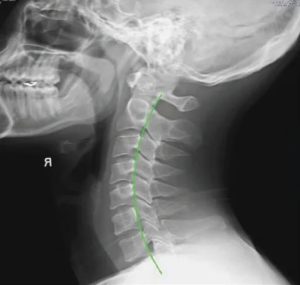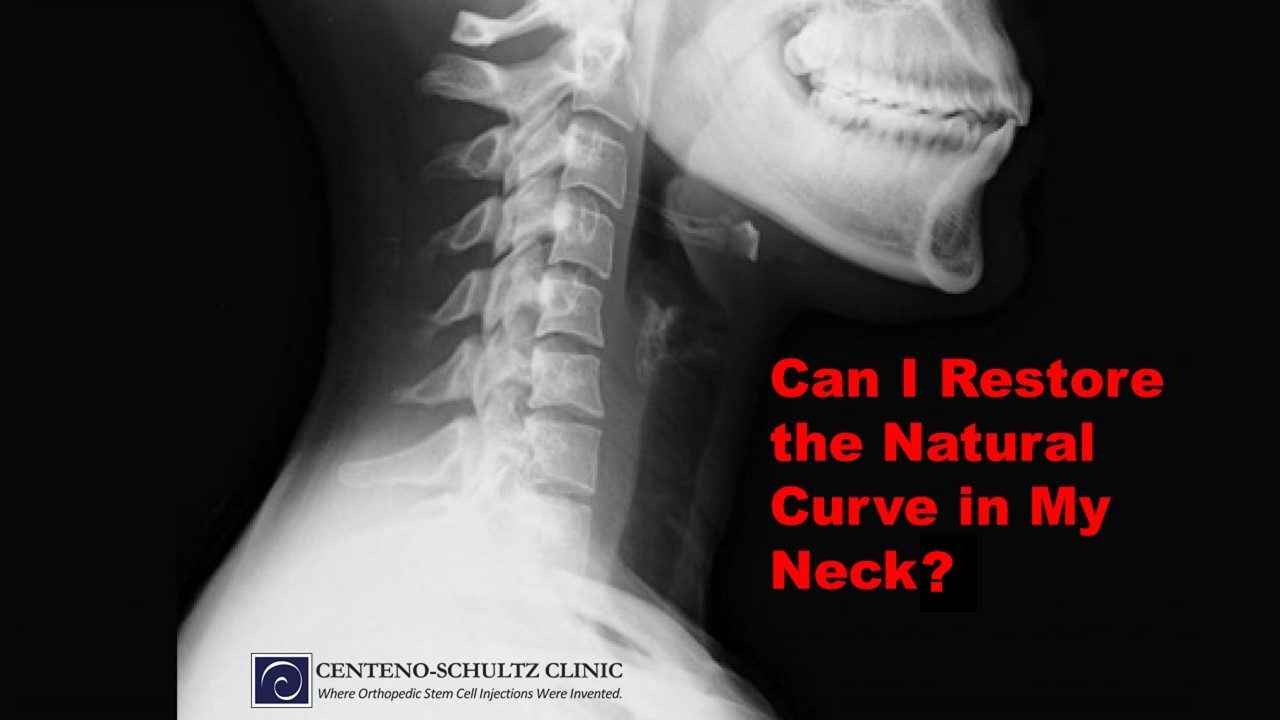The neck pain is now constant. Movement is difficult. Your neck muscles are painful and as hard as rocks. Your chiropractor noted that your neck has lost its curve.
What is the natural curve in the neck? Why is the natural curve significant? What are the signs and symptoms that your natural curve is compromised?
What are the six easy steps to restore the natural curve in your neck? What should you do if conservative options do not restore the natural curve? What are the five causes that result in the loss of the natural curve in the neck?
What are the treatment options for disc, facet, ligament, and nerve injuries? Three reasons you should care about the natural curve in your neck.
Let’s dig in.
What Is the Normal Neck Curve?

A normal, healthy neck has a gentle C-shaped curve. This is also referred to as a lordotic curve.1 It is normal in the neck and refers to an inward curve. The C-shaped curve is in the opposite direction of your nose, as shown in the illustration. This natural curvature in the spine is important, as it allows for proper biomechanics of the spine, shock absorption, motion, and overall function.
Importance of the Natural Curve
A gentle C-shaped curve ensures proper alignment of all the bones, tendons, and ligaments in the neck. When the neck is properly aligned, it functions accordingly. If the natural C-shaped curve is lost, alignment is compromised, and the bones, tendons, and ligaments are at risk of injury and becoming a source of pain.
Without a normal curvature, your spine is like a car running with misaligned tires. Just like when your car’s wheels are out of alignment, this will cause excessive wear on the tires. The same can be said for your spine: when misaligned, this will cause excessive wear on the elements of your spine, such as disc degeneration, facet arthritis, and instability.
Why You Shouldn’t Ignore the Loss of Your Neck Curves
Loss of curves and neck pain are both warning signs that you have a problem. It is similar to the red “check engine” light that comes on as you are pulling out of town for a four-day road trip. If ignored, you risk:
- Injury to the neck structures, which may be permanent
- Increase in pain and dysfunction
- Possible dependence on NSAID, muscle relaxants, or opioids
Two recent publications are worth noting:
- Loss of the natural neck curve is associated with injuries, including disc herniation. Disc herniation is when the soft, jelly-like interior of the disc explodes outwardly due to weakness or injury of the sidewall. This is similar to a pimple when it pops.
This study followed three hundred young patients with neck pain and abnormal neck curves for four years.
The authors demonstrated that loss of the natural neck curve increased the risk for disc herniation.10 The greater the loss of the neck curve, the greater the risk for disc herniation. OUCH! - A separate study examined subjects’ cervical spines and their ability to tolerate the forces of daily living. In one group, the neck curve was normal, whereas in the other group, there was a loss of the natural curve.
The authors demonstrated that the loss of the natural neck curve makes the neck weaker and less able to withstand the forces of daily living.11 In other words, a straight spine makes the neck weaker and less able to tolerate the forces of daily living.
Loss of Neck Curve Symptoms and Signs
Symptoms vary depending on the severity of the misalignment. Common signs and symptoms include:
- Neck pain
- Decreased range of motion
- Headache
- Fatigue
- Muscle tension
- Balance problems
- A decrease in blood flow to the brain
- Heavy head
The loss of the cervical curve is associated with decreased blood flow to the spinal cord and brain. That may explain why you feel sluggish and forgetful at times. Dr. Katz demonstrated this in Boulder, and this is one of his most recent papers.3
Injuries That Can Compromise the Natural Curve in Your Neck
Questions always arise, did the loss of curve come first, or did injuries to the spine cause the loss of curve? This is a chick or egg scenario!
Neck Disc Injury
The spine is composed of bony building blocks that are stacked upon one another. Sandwiched between the bones are soft spacers called discs. Discs are important shock absorbers, but they are susceptible to injury. Common examples include disc protrusion and disc herniations.
Disc injuries can cause pain and a significant loss of curves in the neck.8
Neck Facet Injury
A facet is a small, cartilage-lined joint on the backside of the spine. It is a paired joint, with one on the right and one on the left at each level of the spine. For example, there is a right and left C2/3 and C3/4 facet joint, and so on. The facet joints guide and limit the motion of the spine.
The facets are susceptible to injury due to degeneration, trauma, surgery, and instability. Facet injuries can cause neck pain, restriction in movement, and loss of the natural curve in the neck.
Neck Ligament Injury
Ligaments are thick pieces of connective tissue that connect one bone to another. Ligaments provide important stability for the neck. Multiple ligaments in the neck provide support and keep your head attached to your neck.
Unfortunately, ligaments can be injured, leading to instability, pain, restriction in range of motion, and loss of the natural curve in the neck.9 Trauma is the leading cause of neck ligament injuries.
Nerve Injury
At each level of the neck, a spinal nerve exits the spine. The medical profession numbers these nerves, which travel to different muscles and other structures. For example, the C6 nerve exits the mid to lower neck and provides sensation and strength to the muscles of the forearm, thumb, and index finger.
This information explains normal muscle function and why it is important to maintain a natural curve in the neck. The nerve can be irritated or compressed, leading to dysfunction. Common examples include disc bulge, disc herniation, facet, and ligament overgrowth. Irritation or compression of the nerve can result in loss of the natural curve in the neck.
Neck Muscle/Tendon Injury
Muscles stabilize and support your neck and head. This is a herculean task given that your head weighs approximately 10 lbs. Muscles can become injured or fatigued. Tendons are thick bands of connective tissue that connect muscle to bone.
Tendons can become inflamed, degenerative, or partially torn, leading to pain and restriction in range of motion. Injury to both muscles and tendons can cause the loss of the natural curve in your neck, pain, and dysfunction.
A previous blog discussed how muscles immediately beneath the skull, called suboccipital muscles, can cause pain at the base of the skull.
Six Easy Steps to Restore the Natural Curve in Your Neck
While getting curve restoration is not a simple task, here are a few ways to improve your current curvature to get you started on the road to curve restoration!
1. Improve Posture
Cell phones, tablets, and laptops all compromise neutral spinal alignment. When the head is in line with the spine and directly over the shoulders, the cervical spine can distribute the head’s weight evenly throughout the joints. This allows us to maintain the natural curve in our necks.
2. Optimize Your Work Station
Proper adjustment and height of your chair and desk are important to maintaining a normal neck curve. The top of your monitor should be at or slightly below eye level. Your chair should be adjusted so that your feet rest flat on the floor.
3. Limit Screen Time
Our digital age requires extended screen time (use of laptops, tablets, and cell phones), which can cause muscle fatigue and poor posture. These can undermine the natural curve in your neck. Take periodic breaks.
4. CBP Chiropractic Care
CBP(Chiropractic BioPhysic) chiropractic care is a specialized protocol for chiropractors who look towards spinal rehabilitation and postural correction to address pain, disease, and organ dysfunction. It emphasizes optimal posture and spinal alignment.
Multiple non-randomized and randomized clinical trials have demonstrated their effectiveness in restoring the natural curve of the neck.4,5 Case reports have also demonstrated clinical improvement in curves and symptoms in 10–14 weeks.6,7
5. Physical Therapy
Physical therapy can be an effective treatment option to restore the natural curve in the neck. Treatment options include neutral spinal alignment, range of motion, strengthening exercises, trigger point injections, and muscle manipulation and activation.
6. Identify the Underlying Cause of Neck Pain
Is your neck pain a constant companion that never quite goes away? Are your neck muscles super tight and painful? These can compromise the natural curve in your neck. If that is the case, it is time to dig deeper. It is time to get an accurate diagnosis. Neck pain and neck spasms are not diagnoses. Rather, they are symptoms of something more profound. Think of them as warning signs.
Treatment Options for Disc, Facet, Ligament, and Nerve Injuries
Appropriate conservative therapy should always be the first-line treatment. Examples include physical therapy, massage, chiropractic care, and stretching. When these treatment options fail to reduce pain and increase function, it is time to find a specialist.
Your orthopedic surgeon will provide one of three options: physical therapy, steroids, or surgery. Steroids are toxic to cartilage, muscles, and tendons and should be avoided. No literature indicates they effectively restore the natural curve in the neck. Orthopedic surgeons are biased by their training and often offer solutions that are not in your best interest.
Where to Go?
Find a doctor who has specialized training in interventional orthobiologics. Typically, these doctors are board-certified in physical medicine, anesthesiology, or sports medicine and have elected to spend additional years of training in non-surgical treatment options for orthopedic injuries.
Interventional orthobiologics is a very exciting new medical specialty that utilizes the unlimited potential of platelets and stem cells to heal common orthopedic conditions. All injections are performed using ultrasound or X-ray guidance to ensure the placement of the cells or platelets.
All the physicians at the Centeno-Schultz Clinic are masters in interventional orthopedics. We all teach our fellows and physicians from different parts of the nation and the world. To learn more about interventional orthopedics, please click on the video below.
We Can Help by Encouraging Your Body’s Own Healing Mechanism
If you have significant neck pain or limitations and have been diagnosed with a loss of spine curvature, with the steps above, proper curvature can be achieved.
But if you or a loved one is having difficulty achieving better alignment or stability, please schedule a telemedicine consultation. This can be performed from your home, office, or mountain or beach retreat. Schedule now and stop the limitations, pain, and suffering.
Restore your natural neck curve with the Centeno-Schultz Clinic. Check out our at-home self-neck exam today.
